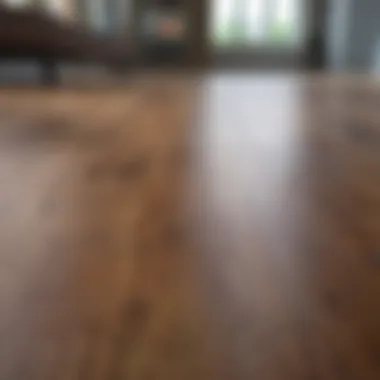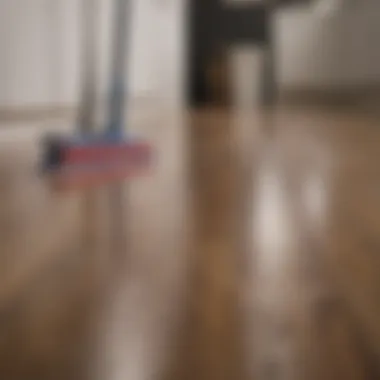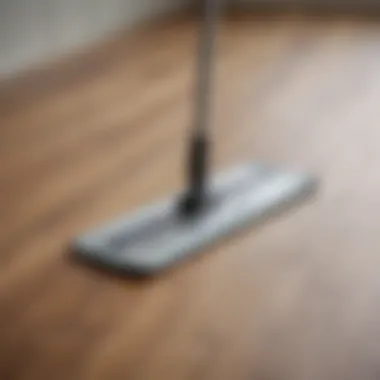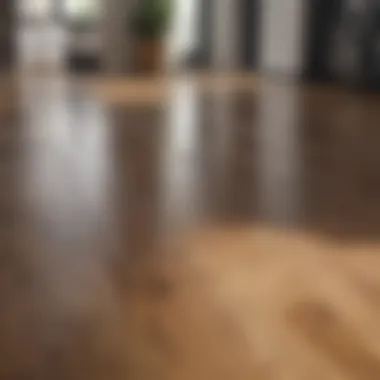Mopping Laminate Floors: Essential Tips and Techniques


Intro
When it comes to maintaining the beauty of laminate floors, mopping presents a common challenge for many homeowners. Laminate flooring is a popular choice due to its durability and aesthetic appeal. However, it is essential to understand how to clean it properly without compromising its integrity. This article aims to explore effective methods and tools to mop laminate floors, ensuring they look their best for years to come.
The key to preserving the allure of laminate surfaces lies in the right approach to cleaning. Homeowners often wonder if they can use traditional mopping techniques or if they should consider alternative options. Alongside detailed methods for mopping, this guide will cover various products suited for laminate, maintenance tips, and things to avoid during the cleaning process. With the proper knowledge, every homeowner can keep their floors pristine.
Understanding Laminate Flooring
Understanding laminate flooring is crucial before delving into cleaning practices. Laminate flooring is an economical alternative to hardwood with appealing aesthetics. It is essential for homeowners to grasp not only what laminate is but also its unique construction and durability features. This knowledge ensures the right care practices are employed, which can significantly extend the floor's lifespan.
What is Laminate Flooring?
Laminate flooring is a multi-layer synthetic flooring product fused together through a lamination process. It consists of a high-density fiberboard core that provides stability and comfort. The top layer features a photographic image that mimics wood, stone, or other textures, while several protective layers prevent scratches and wear. This flooring type is popular due to its affordability and ease of installation, making it a suitable choice for a variety of settings.
Composition and Layers of Laminate
The strength and appearance of laminate flooring arise from its distinct layers:
- Wear Layer: The surface layer that resists scratches and stains. Usually made of aluminum oxide, this protects against everyday wear.
- Design Layer: This layer contains the printed design. It can simulate various materials, giving the floor its decorative aspect.
- Core Layer: Composed of high-density fiberboard, it offers durability and stability, protecting against moisture and impacts.
- Backing Layer: This is the base layer that helps prevent moisture from penetrating the core and offers additional stability.
Each layer plays a pivotal role in the performance and longevity of laminate flooring. Understanding these components aids in choosing maintenance practices that best preserve its features.
"Knowledge of laminate flooring helps ensure informed decisions in care and maintenance, leading to enhanced floor longevity."
The interdependence of these layers emphasizes the need for careful cleaning practices. By knowing laminate's structure, homeowners get better insight into what cleaning methods that are safe and effective.
Moisture and Laminate Floors
Understanding the interaction between moisture and laminate flooring is crucial for maintaining its appearance and durability. Laminate floors are designed to be resistant to moderate moisture; however, excess moisture can cause significant damage. This section delves into the implications of moisture on laminate flooring, ensuring homeowners make informed decisions when cleaning.
Impact of Excess Moisture
Excess moisture is the nemesis of laminate floors. When water seeps into seams or beneath the surface, it can lead to warping, swelling, or peeling. This not only affects the floor's functionality but also its aesthetic appeal. In some cases, laminate may become irreparably damaged, necessitating costly repairs or replacements.
To summarize, the main impacts of excess moisture include:
- Warping: When laminate absorbs water, it expands. Over time, this expansion can lead to distortion of the planks.
- Swelling: Similar to warping, swelling occurs when moisture gets trapped, often causing visible bumps or uneven surfaces.
- Peeling: The protective wear layer can separate from the core if moisture penetrates too deeply, resulting in peeling edges.
Addressing these issues with prompt action is vital. Installing a moisture barrier during floor installation can also help mitigate these risks.
Understanding Surface Sealing
Surface sealing plays a key role in laminate flooring's ability to resist moisture. These seals create a protective barrier on the floor's surface, preventing water penetration. However, not all laminate floors have the same quality of sealing.
Here is what to consider in surface sealing:
- Quality of Seal: A high-quality seal will enhance the floor's durability against spills and humidity. Choosing a trusted brand can make a big difference.
- Maintenance of Seal: Over time, the seal may wear down. Regular inspections can help identify deterioration.
- Engaging Professionals: For layers that require maintenance, professional services can help rejuvenate the sealing, providing long-lasting protection.
Managing moisture effectively begins with understanding how sealing works. The awareness increases the potential for laminate floors to withstand everyday challenges while keeping their pristine appearance.
"Preventing moisture damage comes down to understanding and respecting the properties of the flooring material. Regular checks and timely actions are essential."
By keeping these aspects in mind, homeowners can enjoy beautiful laminate floors for years.
Can You Mop Laminate Floors?


Understanding whether you can mop laminate floors is crucial for any homeowner looking to maintain the beauty and longevity of their flooring. Mopping is a common cleaning method for various types of flooring. However, laminate requires specific considerations. Despite its durable appearance, laminate can be sensitive to excessive moisture and harsh cleaning methods. Therefore, it is important to clarify which mopping techniques and products are appropriate. This will help prevent damage and ensure that the surface remains visually appealing.
The Short Answer
In short, yes, you can mop laminate floors, but caution is needed. Laminate flooring consists of multiple layers, including a moisture-resistant core. While it can handle some moisture, it should not be subjected to soaking. The ideal technique involves using a damp mop rather than a wet one. A mop that is too wet can lead to water seeping into seams or joints, which can cause warping and other long-term damage. Therefore, it is vital to use the right amount of water during the mopping process.
When Mopping is Acceptable
Certain conditions make mopping laminate floors acceptable. Here are some scenarios where it is appropriate:
- Regular Cleaning: Mopping is suitable for removing dirt and stains that regular sweeping cannot address. This is especially important in high-traffic areas.
- Minor Spills: If liquid spills occur, quick mopping can be effective if done carefully. Use a damp cloth or mop to absorb spills immediately after they happen.
- Occasional Deep Cleaning: For deeper cleaning, mopping can be used, but it should involve a specialized laminate cleaner and minimal moisture.
Always remember: taking the right precautions can significantly prolong the life of your laminate floors.
In each case, employing a damp mop and an appropriate cleaning solution is essential. Knowing when and how to mop ensures that your laminate floors look their best without incurring unnecessary damage.
Recommended Mopping Methods for Laminate
Mopping laminate floors needs careful consideration to maintain their appearance and durability. The right techniques can effectively clean without causing damage. It is vital to understand the methods used for cleaning to avoid pitfalls that can lead to unsightly outcomes and longevity issues. This section explores the preferred mopping methods tailored specifically for laminate flooring, ensuring optimal maintenance for homeowners.
Using a Damp Mop
When it comes to mopping laminate floors, a damp mop is highly recommended. This technique effectively removes dust and debris without oversaturating the surface. A damp mop ensures that the cleaning solution is applied in moderation, which is crucial to avoid any warping or swelling of the laminate material. Use a well-wrung mop to prevent pooling water on the floor.
One common mistake is to use a soaking wet mop. Excess water can seep into seams or gaps, compromising the integrity of the floor. Instead, aim for a slightly damp mop that can capture dirt while preserving the flooring. This method not only cleans effectively but also maintains the sheen of the laminate.
Choosing the Right Cleaning Solution
Selecting an appropriate cleaning solution is equally important when mopping laminate floors. Many household cleaners are either too harsh or contain chemicals that may leave residues or dull the finish of the floor. It is recommended to use pH-neutral cleaners specifically formulated for laminate or hardwood floors.
Common choices include:
- Vinegar and water solution
- Commercial laminate floor cleaner
Always test your cleaning solution on a small, inconspicuous area before applying it broadly. This step confirms that it will not damage the laminated surface or affect its appearance. Following the manufacturer's instructions for dilution and application ensures optimal results.
Microfiber Mops: An Ideal Choice
Microfiber mops are an ideal tool for cleaning laminate floors. They have several advantages when compared to traditional mops. First, microfiber pads effectively trap dirt and dust, reducing the need for excess moisture. This characteristic is essential for laminate floors, which require careful handling to avoid water damage.
Additionally, microfiber mops are gentle on surfaces. They do not scratch or scuff the laminate like some bristled mops can. Using a microfiber mop also allows for easy cleaning of corners and edges, where dust tends to accumulate. It enhances convenience, making regular maintenance simpler and an enjoyable task.
Common Pitfalls of Mopping Laminate Floors
When it comes to maintaining the beauty and longevity of laminate flooring, understanding the common pitfalls of mopping is essential. This section focuses on three major issues: over-saturation, harsh cleaning chemicals, and improper scrubbing techniques. Each of these can lead to significant damage, reducing the lifespan and appearance of your floors. By recognizing these traps, homeowners can take informed steps to ensure their laminate surfaces remain attractive and functional.
Over-Saturation Concerns
One of the most significant risks when mopping laminate floors is over-saturation. Laminate is designed to handle some moisture; however, too much water can seep into seams, leading to swelling and warping. Thus, it is crucial to use the right amount of moisture when cleaning.
Consider the following tips to avoid over-saturation:
- Use a damp mop rather than a wet one. Excess water can quickly become a problem.
- Wring out the mop thoroughly before using it on the floor.
- Clean only small areas at a time. This allows you to ensure that no water is left to sit before it dries.
Remember: Moisture seepage can cause irreversible damage to laminate flooring, making it essential to control the water used in mopping.
Using Harsh Chemicals


Another common pitfall is the use of harsh chemicals when mopping. Many homeowners turn to strong cleaners to tackle tough stains, but these products can damage laminate surfaces. Ingredients like ammonia or bleach can strip the protective layer of laminate flooring, leading to dullness and discoloration over time.
To avoid this, consider these suggestions:
- Opt for pH-balanced cleaners specifically designed for laminate. This ensures safety without compromising cleaning power.
- Test any new product on a small, inconspicuous area before applying it more broadly. This step can prevent unwanted surprises.
- Avoid using vinegar or other acidic cleaners that can break down the sealant over time, leading to further issues.
Scrubbing Techniques to Avoid
Improper scrubbing techniques also pose a risk to laminate floors. Scrubbing too hard or using abrasive tools can scratch or damage the surface. Homeowners may not realize that circulation of dirt and debris can cause more harm than good.
Here are some techniques to avoid:
- Do not use a bristle brush or steel wool. These tools can create irreversible scratches.
- Avoid excessive pressure when mopping. Gentle sweeping motions allow for effective cleaning without damage.
- Use the right mop: Microfiber mops are ideal because they trap dirt and grime without excessive force.
By being aware of these common pitfalls, homeowners can take proactive steps in maintaining their laminate floors. Following the recommended practices in cleaning can promote a polished appearance while ensuring longevity and quality.
Alternatives to Mopping
In the context of maintaining laminate floors, exploring alternatives to mopping is essential. Laminate flooring is sensitive to excess moisture, and many homeowners seek safer cleaning methods. These alternatives not only reduce the risk of damage but also maintain the aesthetic appeal of the flooring, ensuring its longevity. Understanding different cleaning techniques allows you to choose the most suitable options for various situations.
Sweeping vs. Mopping
Sweeping is a primary method for cleaning laminate floors. It involves using a broom or a microfiber sweeper to gather loose dirt and debris. This method is advantageous because it does not introduce moisture to the floor, thus preventing warping or swelling. Regular sweeping is vital for routine maintenance and can be done daily or as needed.
When comparing sweeping to mopping, it is important to recognize the limitations of each method. Mopping may be necessary for sticky or tough stains, but it comes with risks. Sweeping alone is often sufficient for routine cleaning, limiting moisture exposure while still keeping the laminate surfaces clean.
In situations where deeper cleaning is required, a damp mop can be employed with caution.
Dry Dusting Methods
Dry dusting methods provide another effective strategy for laminate care. A dry microfiber cloth or a dust mop can effectively capture dust and allergens without the use of water. These tools are specially designed to attract and hold dust particles, ensuring that your laminate floors remain clean and do not suffer from excessive moisture.
Using dry dusting sweeps or cloths regularly helps reduce the buildup of dirt and debris, which is essential for preserving the appearance of your flooring.
Spot Cleaning Techniques
Spot cleaning is a necessary approach to address localized stains or spills without subjecting the entire floor to moisture. When a spill occurs, it is important to act quickly. First, use a dry cloth or paper towel to absorb as much of the liquid as possible. After that, a slightly damp cloth can be used gently to clean the affected area.
Consider using a pH-balanced cleaner designed for laminate surfaces if necessary. This method is effective because it targets specific areas, minimizing moisture exposure to the rest of the floor.
Spot cleaning is not just about aesthetics; it helps maintain the integrity of the laminate floors and protects against long-term damage from spills.
By understanding and effectively implementing these alternatives to mopping, homeowners can significantly enhance the longevity and beauty of their laminate flooring.
Best Practices for Cleaning Laminate Floors
Cleaning laminate floors properly is essential for maintaining their appearance and longevity. Neglecting best practices can lead to damage. Therefore, understanding how to take care of these floors can save you time and money in the long run. The right techniques and tools can prevent scratches, warping, and fading. This section explains crucial elements in maintaining laminate floors effectively.
Routine Maintenance Tips
Routine maintenance is key to saving laminate flooring from unneeded wear. Regular cleaning with a dry mop or vacuum minimizes dirt and dust accumulation. This step prevents particles from scratching the floor’s surface. Aim to clean high-traffic areas more often. For deep cleaning, use a slightly damp mop with a laminate-friendly cleaner.
When cleaning, avoid products containing high levels of soap or wax. They can lead to buildup that dulls the floor's finish.
Important: Always sweep or vacuum before mopping to enhance the cleaning process.


Timing Your Cleanings
Timing plays a significant role in the cleaning process. Establish a schedule based on the level of foot traffic in your home. If your household has pets or children, more frequent cleanings are necessary. A weekly cleaning schedule might be sufficient for less busy homes. However, don't wait for visible dirt to appear.
This proactive approach prevents grime from settling into the floor, making it harder to remove. Consider the seasons too; sand and salt from winter can harm the floor. Therefore, ensure a focus on cleaning right after these seasons.
Using Area Rugs and Mats
Area rugs and mats can protect laminate floors from scratches and scuffs. Place them in entryways and high-traffic zones. This addition captures dirt before it can reach the laminate surface. When choosing rugs, opt for ones with a non-slip backing. This prevents movement that can lead to accidents.
Also, ensure to clean the rugs regularly. Dirty rugs can harbor dirt and lead to issues for the laminate flooring. In addition to beauty and style, area rugs serve a practical function in floor care, enhancing the overall upkeep.
Following these best practices ensures your laminate floors remain beautiful and in optimal condition.
Long-Term Care for Laminate Floors
Long-term care for laminate floors is crucial for maintaining their appearance and functionality over time. Laminate flooring, while durable and resistant, is not impervious to damage. Regular maintenance can significantly extend its lifespan and keep it looking as good as new. This section will explore two important aspects: dealing with scratches and dents, along with preventing discoloration.
Dealing with Scratches and Dents
Scratches and dents are common issues faced by laminate floor owners. Even with careful use, furniture and foot traffic can lead to surface imperfections. Here are some strategies to address these problems:
- Use a repair kit: Many manufacturers produce repair kits specifically designed for laminate surfaces. These kits usually include wax fillers, markers, and finishing glosses that help to blend the repair with the existing floor.
- Sand lightly: If the scratch is deep, you may consider gently sanding the area. Use fine sandpaper and be cautious not to over-sand. After sanding, you may need to apply a sealant to protect the area.
- Replace planks: In severe cases, replacing the damaged plank might be necessary. Identify the damage location, carefully remove the affected plank, and install a new one. This option offers a longer-lasting solution.
Remember, addressing scratches and dents as they appear is essential. Procrastination can lead to more extensive damage and higher repair costs.
Preventing Discoloration
Discoloration can significantly impact the aesthetic appeal of laminate floors. Several factors contribute to this issue, including sunlight exposure, spills, and harsh cleaning chemicals. Here are some preventive measures you can take to keep your laminate floors vibrant:
- Use area rugs: Strategically placing area rugs in high-traffic zones can absorb impact and limit exposure to direct sunlight. This will help reduce fading over time.
- Adjust furniture placement: Regularly rearranging furniture can prevent uneven wear patterns and prolonged exposure to sunlight in one specific area.
- Choose the right cleaners: Avoid using abrasive or acidic cleaners. Stick to products specifically formulated for laminate floors. Always read labels to ensure compatibility.
"Proper care today retains the beauty of laminate floors for tomorrow."
In conjunction with cleaning, consider sealing your laminate floors every few years. This step adds an extra layer of protection against discoloration and wear.
In summary, long-term care of laminate floors involves being proactive about scratches and preventing discoloration. By taking these actions, homeowners can preserve the beauty and durability of their laminate surfaces for years to come.
Ending
The conclusion of this article serves as a crucial synthesis of the key insights regarding mopping laminate floors. Understanding how to maintain and clean laminate surfaces properly is essential to preserving their aesthetic appeal and longevity. Many homeowners are unaware of the specific care laminate flooring requires, leading to potential damage and dissatisfaction.
Key elements discussed in this guide include:
- The importance of moisture control to avoid warping.
- Recommended safe mopping methods and suitable products.
- Common mistakes that can lead to damage.
By adhering to these practices, one can significantly enhance the durability and appearance of laminate flooring. This knowledge is not only beneficial for the upkeep of your home but also adds to its value in the long term.
"Caring for laminate floors requires informed practices to keep them looking their best over time."
Moreover, the article has deliberated on alternatives to traditional mopping, underscoring the diversity of cleaning techniques available. This approach empowers homeowners to choose methods that suit their lifestyles while maintaining the quality of their floors.
In summary, maintaining laminate flooring entails a blend of awareness, appropriate strategies, and routine care. Each of these facets contributes to sustaining not just the appeal but also the functionality of the laminate—a wise investment for any homeowner.
Summary of Key Points
- Laminate flooring requires careful cleaning methods to avoid moisture damage.
- Safe mopping practices include using a damp mop and non-abrasive cleaners.
- Alternatives like dry dusting and spot cleaning can also be effective.
- Routine maintenance is essential to prevent wear and tear.
Final Recommendations
- Invest in a quality microfiber mop for optimal performance.
- Regularly sweep or vacuum to minimize grit that can scratch the surface.
- Always use a damp, not wet, mop to avoid excess moisture.
- Consider using area rugs in high-traffic areas to reduce wear.
- Be cautious with chemicals; only use those specifically formulated for laminate floors.
By following these guidelines, homeowners will not only protect their laminate flooring but also enhance its lifespan, ensuring it remains a beautiful and functional element of their home.







